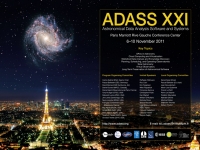Sumiko Kida (Waseda University), Ryota Hiruma, Takahiro Aoki, Kuniyuki Asuma, and Tsuneaki Daishido (Waseda University)
Abstract
We report the development of analysis software for the fringe data obtained by using a two-element interferometer and the result of the analysis of the observational data by using this software. Drift scanning surveys are carried out at 1.4 GHz by using eight 20-m dishes at the Waseda Nasu Observatory. The observation modes are a four two-element interferometer mode and an eight-element interferometer mode. In January 2010, a space-based first Fourier transform processor that consisted of a two-step Radix-4 based on a field-programmable gate array was introduced; by using this processor, complex A/D conversions with Nyquist rate sampling (20 MHz) could be carried out. The detection sensitivity of this processor is better than that of the earlier diode detector, and the number of detected fringes has increased. We have developed this analysis software to distinguish among the many fringes obtained in the two-element interferometer mode on the basis of the threshold provided by the probability distribution of the peak strength of the amplitude spectrum strength and the spectrogram. After the fringe data are compressed into 1 point/second and converted into SNR by a short-time Fourier transform, they are compared with the threshold. The considerable observational data obtained over a period of about 70 days are analyzed with this software, and the appropriateness of the threshold is evaluated.Paper ID: P067
Poster Instructions
|

